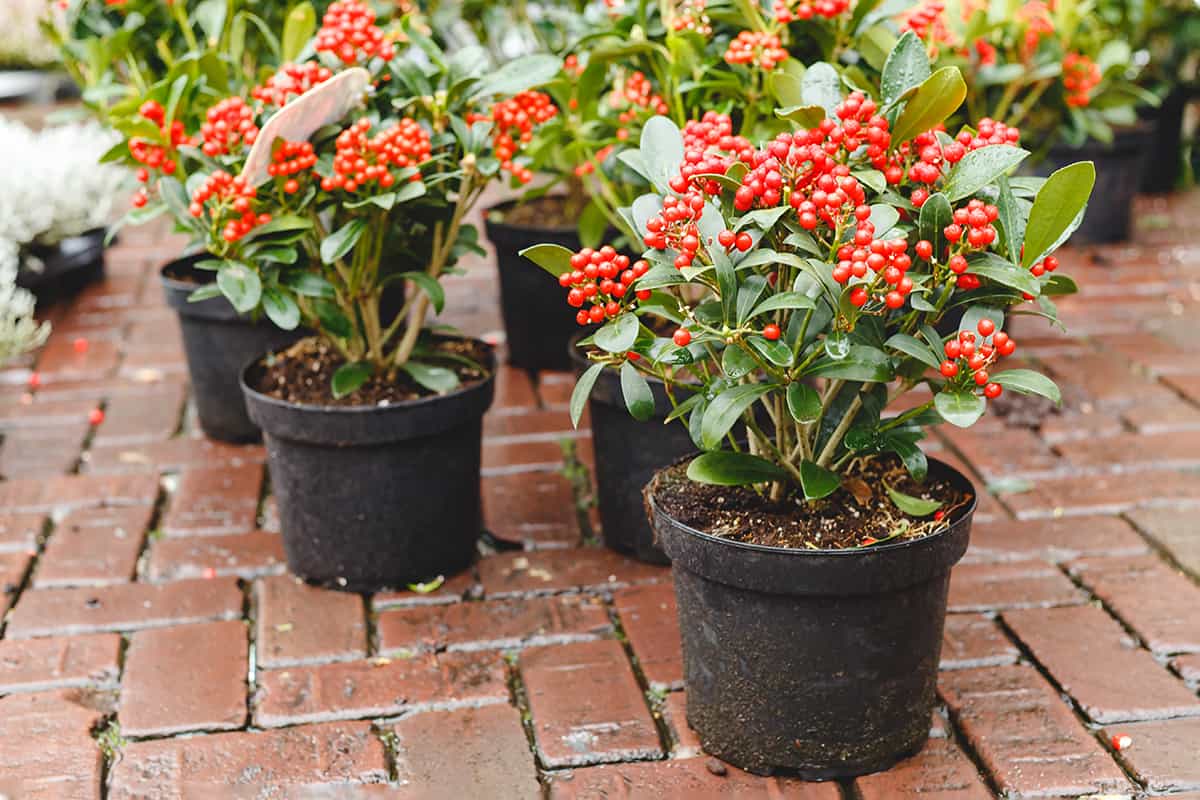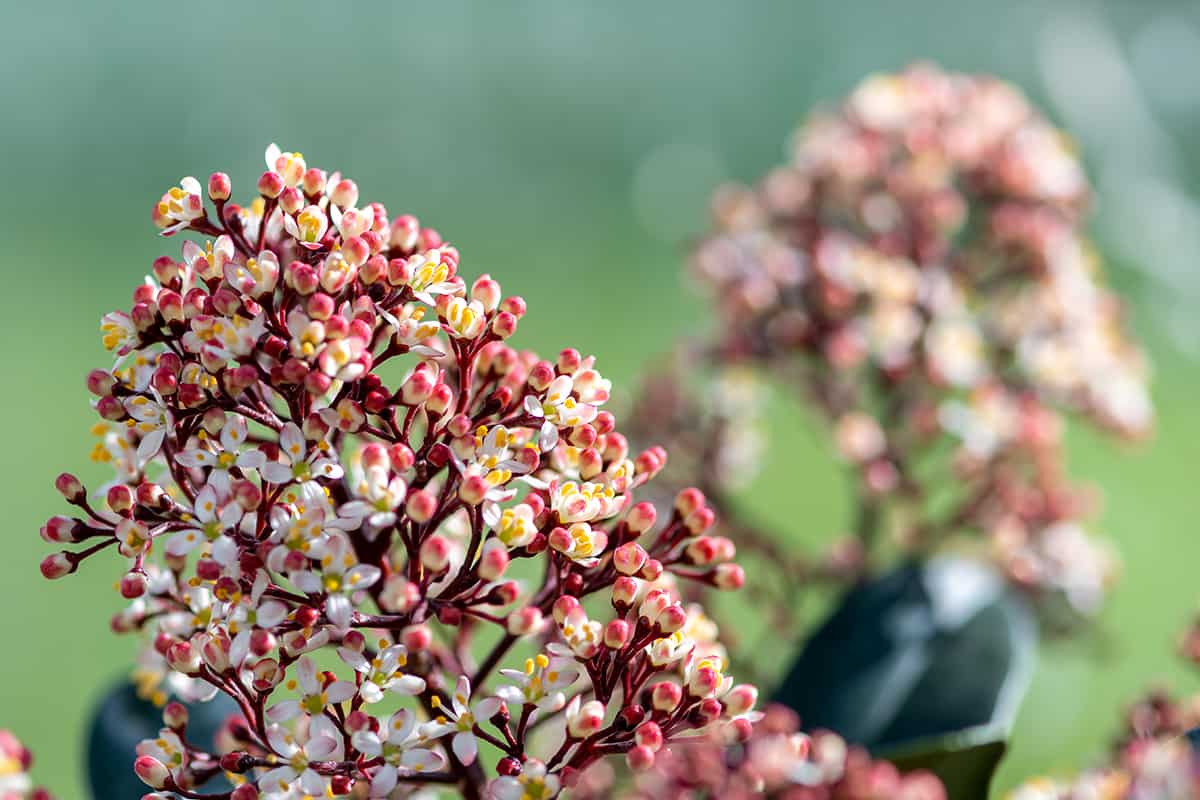An evergreen shrub known for its colorful winter berries, skimmias are favorites in many gardens as flower borders or container plants. These shrubs grow with male and female flowers, and those who wish to have them in their garden often ask how close to plant them.
Luckily, we've done some research and have the answers below!
A male and female skimmia plant should be planted about 1-1.5 meters apart. Bees help pollinate skimmias, and these hardworking insects can fly for miles at a time, so the distance is irrelevant if they are in the same garden.
However, keeping male and female skimmias close together will ensure that they will be pollinated and will always bear flowers.
Determining how far skimmia plants should be to ensure pollination is essential if you want the plants to have flowers and berries all the time. In this post, we will also talk about the differences between male and female skimmias. We also have some tips on caring for skimmia, so keep reading!
How Close Do You Plant Male & Female Skimmia?

If you are going through a garden and looking at beautiful bright red buds, then you probably see skimmia.
These pretty buds come from an evergreen shrub with glossy, bright green leaves. They bloom with fragrant white or yellow flowers in the spring, which turn into bright red berries in the winter.
Skimmia shrubs have both male and female varieties. They are dioecious plants, meaning that for the female plant to grow berries, a male plant must be nearby to pollinate the flowers.
Some skimmia varieties are self-fertile, but they create more berries if a male plant is close to them.
When planting skimmia and you want the plants to bear fruit, it's essential to have both male and female varieties. Generally, you don't need to plant one male plant for every female flower.
You can have one male skimmia for every six female skimmia plants in a garden. You can grow them together in a group to allow better pollination.
Once you have the skimmia plants, the male and female skimmias can be planted at a distance of about 1 to 1.5 meters apart.
This distance should be enough for the pollen of the male skimmia to pollinate the female skimmia's flowers. The wind can blow the pollen to its partner plants, but the best pollinators are still bees.
The distance between the male and female skimmia plants does not matter if bees pollinate them.
Bees can fly miles to pollinate flowers, so a male plant farther than 1.5 meters from a female plant isn't an issue. However, the closer distance makes it easier for them to do their job.
What Is The Difference Between Male & Female Skimmia?

Since one of the requirements necessary for skimmia to flower and bear fruit is male and female varieties, people often ask about their differences.
These two varieties have distinct differences that can help you pick a male or female skimmia plant.
Distinguishing between the two varieties requires looking at the flower of the plants. Flowers typically have stamens and carpels that help you determine whether they are male or female.
If the skimmia flower has five stamens (or the pollen-producing part of the flower), it is a male plant.
You may notice that it will have pollen on the tips of the stamens, particularly if bees haven't pollinated it. When the skimmia flower has three carpels, this is a female plant.
Another way to check if you have a male or female skimmia is to look at the fruits. This is the best way to check if your plants are done for the flowering season. Male plants do not bear fruit, while female plants bear clusters of red berries during winter.
Are There Specific Varieties For Male And Female Skimmia?
If you're planning to get Skimmia plants but are not quite sure if you're getting the right variety, the best way would be to go to a garden or plant nursery.
A male and female skimmia plant are two different varieties. If you are buying seeds or seedlings, you won't know what you'll get unless you get specific when you buy them.
When you buy skimmia plants from the nursery, ask them for these specific varieties. These varieties can be planted together to ensure you'll have flowering and fruiting skimmia plants all year.
Male Skimmia

- Skimmia japonica 'Rubella'
- Skimmia japonica 'Fragrans'
- Skimmia x confusa 'Kew Green'
Female Skimmia
- Skimmia japonica 'Nymans'
- Skimmia japonica 'Veitchii' or 'Foremanii'
Hermaphrodite Skimmia
For those living in a small space or looking into planting skimmia in containers, a hermaphrodite skimmia will be a good choice.
These skimmia plants are self-fertile, meaning they won't need a separate plant's help to bear fruit.
However, since they are self-fertile, they won't have flowers like the male or female varieties. Hermaphrodite varieties of skimmia plants will only bear fruit.
- Skimmia japonica subsp. Reevesiana
- Skimmia japonica 'Temptation'
How Do You Care For Skimmia Plants?

One of the benefits of having skimmia plants is the easy care these plants need. They are generally very low-maintenance plants but tend to attract aphids and other similar insects.
However, this can quickly be resolved by insecticidal soap or quick bursts of water to remove the insects.
Growing In Containers

Skimmia plants are not fans of the sun. They like the shade, so they are best suited for areas in the garden where they can get coverage when the sun is too high.
This makes them perfect container plants, as skimmias grow well indoors in plastic pots.
Check out these plastic plant pots on Amazon.
When planting skimmia in containers, it's essential to water the shrubs regularly.
The soil tends to dry out quickly when in containers, so remember to keep the soil moist and not allow it to dry.
Keep the plant pots away from direct sun, so make sure that the pots are in a shady location.
Soil And Fertilizer
For soil, skimmias love it when it is moist and well-draining. Loam soil is the best for skimmia plants because it retains water well but drains without waterlogging the plant.
Skimmias like acidic soils, so avoid planting them in soil with high pH. If this is the case, always add compost or organic matter to balance out the ground.
Since skimmia is not a high-maintenance plant, fertilizing it can be done yearly. This fertilizer will help improve the plant's growth, especially the new buds.
Skimmias will thrive in fertilizer formulated for acid-loving plants. To check if you need to fertilize your skimmias, check the leaves if they look faded.
Underfertilized plants may also grow stunted and look pale.
Get this 10-5-4 fertilizer on Amazon.
Pruning And Other Useful Information For Skimmia
Skimmias do not need regular pruning, which is good news for those who are not very keen on doing this task all the time. These plants are known to be compact, so they don't need heavy pruning.
They tend to keep it neat on their own, but you can prune the plant during winter to keep the shape of the shrubs and the branches clean.
When it comes to the temperature of growing skimmia plants, you'll be happy to know that they can grow anywhere. They are winter-hardy plants and can tolerate temperatures of up to 5°F.
For best results, they're better off in moderate temperatures and do well in USDA zones 6 to 8.
Propagation
Skimmia can be grown from seeds or cuttings. The best way to propagate skimmia is through a softwood cutting during mid-winter or autumn.
Hardwood cuttings can also be used to propagate if they are taken in late autumn to late winter.
However, if you want a challenge, you can plant skimmia by propagating them from seeds. You can do this by collecting the ripe berries on the plant and removing the seeds for planting.
Immediately plant them on trays and keep them outdoors so the cold weather will break the seed's dormancy.
To Finish Up

The skimmia plant is an excellent choice if you wish to have an evergreen shrub that looks beautiful throughout the year.
Make sure to plant both a male and female variety in your garden to ensure that they will flower and bear fruit. They are easy to care for, and you'll surely be rewarded with this beautiful plant.
And while we have your attention, check out these related articles:


